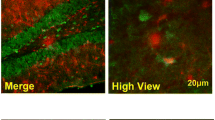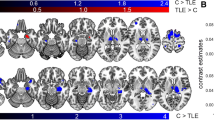Abstract
Mesial temporal lobe epilepsy (MTLE) is a frequent form of focal intractable epilepsy in adults. We previously reported overexpression of vascular endothelial growth factor C (VEGF-C) and its receptors, VEGFR-2 and VEGFR-3, in epilepsy-associated tuberous sclerosis complex. To identify whether VEGF-C and its receptors are involved in epileptogenesis of MTLE, we investigated the levels and expression pattern of VEGF-C and its receptors in temporal neocortex and hippocampus (HPC) from 28 patients with MTLE and ten control (CTX) subjects. Real-time quantitative polymerase chain reaction and Western blotting results revealed upregulated mRNA and immunoreactive protein levels of VEGF-C, VEGFR-2, and VEGFR-3 in the MTLE group compared to the control groups. Immunohistochemistry and double-labeled immunofluorescence showed that VEGF-C was highly expressed in neurons and astrocytes, including reactive astrocytes and vascular endothelial cells, VEGFR-2 was expressed at a high level in reactive astrocytes and vascular endothelial cells, but not in neurons, whereas VEGFR-3 was only overexpressed in reactive astrocytes. Taken together, these findings suggest that VEGF-C and its receptors, VEGFR-2 and VEGFR-3, may contribute to the epileptogenesis of MTLE.





Similar content being viewed by others
References
Abbott NJ, Patabendige AA, Dolman DE, Yusof SR, Begley DJ (2010) Structure and function of the blood-brain barrier. Neurobiol Dis 37(1):13–25
Bae EK, Jung KH, Chu K, et al. (2010) Neuropathologic and clinical features of human medial temporal lobe epilepsy. J Clin Neurol 6(2):73–80
Ballabh P, Braun A, Nedergaard M (2004) The blood-brain barrier: an overview: structure, regulation, and clinical implications. Neurobiol Dis 16(1):1–13
Calvo CF, Fontaine RH, Soueid J, et al. (2011) Vascular endothelial growth factor receptor 3 directly regulates murine neurogenesis. Genes Dev 25(8):831–844
Cammalleri M, Martini D, Ristori C, Timperio AM, Bagnoli P (2011) Vascular endothelial growth factor up-regulation in the mouse hippocampus and its role in the control of epileptiform activity. Eur J Neurosci 33(3):482–498
Crino PB, Nathanson KL, Henske EP (2006) The tuberous sclerosis complex. N Engl J Med 355(13):1345–1356
Dreier JP, Jurkat-Rott K, Petzold GC, et al. (2005) Opening of the blood-brain barrier preceding cortical edema in a severe attack of FHM type II. Neurology 64(12):2145–2147
Engel J Jr (2001) Mesial temporal lobe epilepsy: what have we learned? Neuroscientist 7(4):340–352
Heinrich C, Lahteinen S, Suzuki F, et al. (2011) Increase in BDNF-mediated TrkB signaling promotes epileptogenesis in a mouse model of mesial temporal lobe epilepsy. Neurobiol Dis 42(1):35–47
Jenny B, Harrison JA, Baetens D, et al. (2006) Expression and localization of VEGF-C and VEGFR-3 in glioblastomas and haemangioblastomas. J Pathol 209(1):34–43
Kandratavicius L, Monteiro MR, Assirati JA Jr, Carlotti Jr CG, Hallak JE, Leite JP (2013) Neurotrophins in mesial temporal lobe epilepsy with and without psychiatric comorbidities. J Neuropathol Exp Neurol 72(11):1029–1042
Karkkainen MJ, Haiko P, Sainio K, et al. (2004) Vascular endothelial growth factor C is required for sprouting of the first lymphatic vessels from embryonic veins. Nat Immunol 5(1):74–80
Korn A, Golan H, Melamed I, Pascual-Marqui R, Friedman A (2005) Focal cortical dysfunction and blood-brain barrier disruption in patients with postconcussion syndrome. J Clin Neurophysiol 22(1):1–9
Le Bras B, Barallobre MJ, Homman-Ludiye J, et al. (2006) VEGF-C is a trophic factor for neural progenitors in the vertebrate embryonic brain. Nat Neurosci 9(3):340–348
Liimatainen S, Lehtimaki K, Palmio J, Alapirtti T, Peltola J (2013) Immunological perspectives of temporal lobe seizures. J Neuroimmunol 263(1–2):1–7
Liu YW, Mee EW, Bergin P, et al. (2007) Adult neurogenesis in mesial temporal lobe epilepsy: a review of recent animal and human studies. Curr Pharm Biotechnol 8(3):187–194
Lohela M, Helotera H, Haiko P, Dumont DJ, Alitalo K (2008) Transgenic induction of vascular endothelial growth factor-C is strongly angiogenic in mouse embryos but leads to persistent lymphatic hyperplasia in adult tissues. Am J Pathol 173(6):1891–1901
Malikova H, Kramska L, Vojtech Z, et al. (2014) Different surgical approaches for mesial temporal epilepsy: resection extent, seizure, and neuropsychological outcomes. Stereotact Funct Neurosurg 92(6):372–380
Morin-Brureau M, Lebrun A, Rousset MC, et al. (2011) Epileptiform activity induces vascular remodeling and zonula occludens 1 downregulation in organotypic hippocampal cultures: role of VEGF signaling pathways. J Neurosci 31(29):10677–10688
Morin-Brureau M, Rigau V, Lerner-Natoli M (2012) Why and how to target angiogenesis in focal epilepsies. Epilepsia 53(Suppl 6):64–68
Park JM, Shin YJ, Cho JM, et al. (2013) Upregulation of vascular endothelial growth factor receptor-3 in the spinal cord of Lewis rats with experimental autoimmune encephalomyelitis. J Histochem Cytochem 61(1):31–44
Piltonen M, Planken A, Leskela O, et al. (2011) Vascular endothelial growth factor C acts as a neurotrophic factor for dopamine neurons in vitro and in vivo. Neuroscience 192:550–563
Raab S, Plate KH (2007) Different networks, common growth factors: shared growth factors and receptors of the vascular and the nervous system. Acta Neuropathol 113(6):607–626
Rigau V, Morin M, Rousset MC, et al. (2007) Angiogenesis is associated with blood-brain barrier permeability in temporal lobe epilepsy. Brain 130(Pt 7):1942–1956
Roy H, Bhardwaj S, Yla-Herttuala S (2006) Biology of vascular endothelial growth factors. FEBS Lett 580(12):2879–2887
Shin YJ, Choi JS, Lee JY, et al. (2008) Differential regulation of vascular endothelial growth factor-C and its receptor in the rat hippocampus following transient forebrain ischemia. Acta Neuropathol 116(5):517–527
Shin YJ, Riew TR, Park JH, Pak HJ, Lee MY (2015) Expression of vascular endothelial growth factor-C (VEGF-C) and its receptor (VEGFR-3) in the glial reaction elicited by human mesenchymal stem cell engraftment in the normal rat brain. J Histochem Cytochem 63(3):170–180
van Vliet EA, Aronica E, Gorter JA (2015) Blood-brain barrier dysfunction, seizures and epilepsy. Semin Cell Dev Biol 38:26–34
van Vliet EA, da Costa Araujo S, Redeker S, van Schaik R, Aronica E, Gorter JA (2007) Blood-brain barrier leakage may lead to progression of temporal lobe epilepsy. Brain 130(Pt 2):521–534
Vezzani A, Friedman A (2011) Brain inflammation as a biomarker in epilepsy. Biomark Med 5(5):607–614
Vezzani A, Maroso M, Balosso S, Sanchez MA, Bartfai T (2011) IL-1 receptor/toll-like receptor signaling in infection, inflammation, stress and neurodegeneration couples hyperexcitability and seizures. Brain Behav Immun 25(7):1281–1289
Ward MC, Cunningham AM (2015) Developmental expression of vascular endothelial growth factor receptor 3 and vascular endothelial growth factor C in forebrain. Neuroscience 303:544–557
Zhang CQ, Shu HF, Yin Q, et al. (2012) Expression and cellular distribution of vascular endothelial growth factor-C system in cortical tubers of the tuberous sclerosis complex. Brain Pathol 22(2):205–218
Acknowledgments
This work was supported by grants from the National Natural Science Foundation of China (No. 81370028), the Natural Science Foundation Project of Chongqing CSTC (No. 2012 jjB10019), and the Gansu Natural Science Foundation (No.145RJYA301).
Author information
Authors and Affiliations
Corresponding authors
Ethics declarations
Informed consent and written permission for all procedures were obtained before surgery. All procedures and experiments were conducted under the guidelines approved by the Ethics Committee of the Third Military University (Chongqing, China).
Conflict of Interest
The authors declare that they have no competing interests.
Rights and permissions
About this article
Cite this article
Sun, FJ., Wei, YJ., Li, S. et al. Elevated Expression of VEGF-C and Its Receptors, VEGFR-2 and VEGFR-3, in Patients with Mesial Temporal Lobe Epilepsy. J Mol Neurosci 59, 241–250 (2016). https://doi.org/10.1007/s12031-016-0714-y
Received:
Accepted:
Published:
Issue Date:
DOI: https://doi.org/10.1007/s12031-016-0714-y




